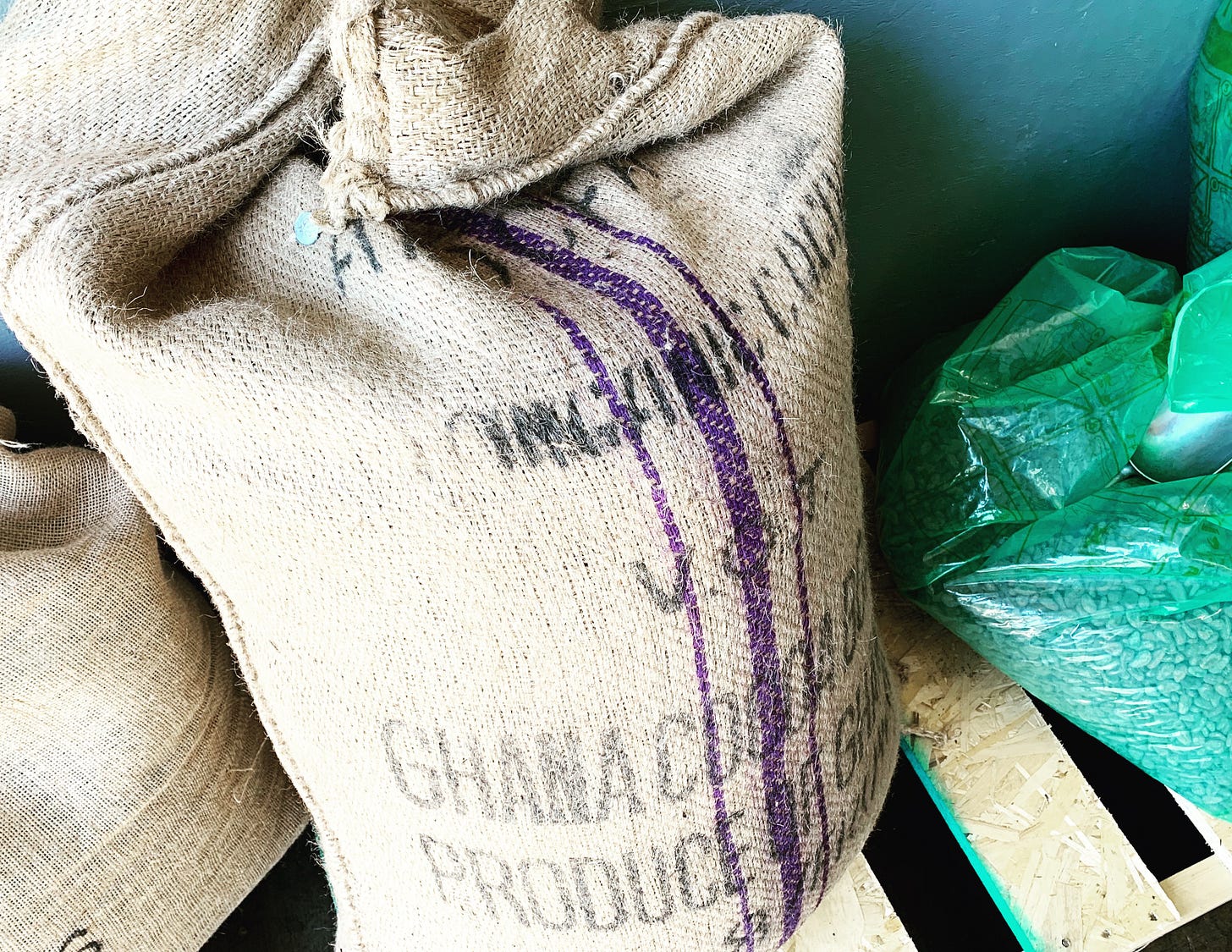how to run a chocolate business
it's all about vision, and that's all about learning how to see down the road

This year is my 11th year running my own business(es) full time. They are wildly different, but also, depend on each other. I wouldn’t have become a chocolate teacher and mentor, and chocolate school founder (that part is actually a third business with it’s own needs), if I wasn’t first a craft chocolate maker.
And I sure as heck wouldn’t be offering my insights if they hadn’t worked.
The longer I’ve been making chocolate, teaching chocolate making, and running my school, the more experience I’ve gained, and the more my confidence has grown. You might feel this way too: gone are the days of losing sleep about a big tempering run in the morning ahead. Maybe you’re making bean-buying decisions you feel great about.
This do it + more doing it = better probably seems obvious, but now is where I have to say no, this isn’t necessarily how the equation works. It can, and should. Just not necessarily. It’s not a given that the longer we persist the better we get. Maybe the wall we keep pushing against hoping for it to crumble is still just the same wall.
Before I say the next bit, heck yes I have tasted chocolate made by brand-new makers that is wonderful. Truly exciting. But wonderful is a rarity when we’re new at crafting, and usually happens early before the steep uphill learning curve. I’ve seen plenty of makers who’ve been at it a long while who don’t make excellent chocolate. We all can and will miss the mark: what I’m talking about here is consistent meh.
Though I have seen many more makers who have grown into crafting better chocolate, this doesn’t always hold true for running their business well, or profitably.
Why? there are many reasons.
A few frequent problems and their consequences:
workspace is not organized for productivity and efficiency (causes maker burnout, equipment malfunctions, health code issues, stress for employees, is seen as unprofessional)
rental space with high overhead (loss of revenue, hidden costs including insurance, may require staffing which adds to overhead)
high labor costs (are always the highest cost of business)
lack of a budget (causes higher cost for unexpected expenses, late payments, contract issues, lack of working capital, reliance on personal funds, increases debt risk)
trying to make too many different products and/or working with too many different origins (creates confusion for customers because it makes it harder to choose, creates more work for the maker, requires more packaging which requires more storage space, is problematic if the maker is trying to keep wholesale accounts stocked)
misunderstanding of accounting (can lead to late tax payments and penalties)
packaging costs are too high (causes loss of revenue)
packaging does not reflect the quality and/or price (causes loss of sales, leads to disappointment and loss of referalls/customer satisfaction)
ratio of wholesale to retail sales is not balanced (causes loss of revenue; this ratio is unique to each business and should be key part of a growth plan)
lack of differentiation in the marketplace such as %, flavor, packaging, vibe, origins, pricing (causes loss of sales, loss of potential wholesale accounts, blurred-eye syndrome aka lost in the crowd)
There is no equation or formula for creating a great business, just like there is no 1-2-3 formula for creating “great” chocolate. I think this is why terrible business approaches are everywhere, yet are imitated. Sounds crazy, but it’s true. I call it the see-saw effect: we see it and by seeing it, accept it as proof it works.
A recap: small makers can’t look at big or fellow small craft makers (but especially the big ones who’ve scaled) and assume “they bought all that equipment” or “can afford that gorgeous new shop/packaging” based off of their chocolate bar sales. That’s not how business works after a certain point.
It works like this: because poorly-run and/or conceived businesses are everywhere and common, they must be the way to run a business, and this means they must work because they’re so common.
There’s learning the skills, methods, and techniques for crafting chocolate, which in and of itself is pretty straightforward. It’s all the zillions of micro and macro decisions that come in that determine meh vs amazing and memorable.
In business there are also certain skills: time management, organization of our process and production flow, budgeting, personnel (if you have employees), planning, juggling responsibilities, pivoting direction if/when needed, etc etc (etc).
A business is not just these tasks, which of course can be delegated or handed off to a manager, or a team, or multiple teams. A business needs, no matter what the size, something best described as
vision.
Vision is unique and specific to you and what you want to accomplish or change in this world or achieve.
I had my vision for Map and for the Next Batch School: it’s in both names.
MAP would be Mackenzie and People, the people who would somehow find their way to a tiny, two-hands-crafting maker who did not want to fit in but wanted to craft whatever and however she was inspired. In other words, my vision was to make my interpretation of craft chocolate, for people who wanted something rare, and not found in the grocery store or Whole Foods. And I didn’t set out to change the way chocolate was crafted or the possibilities and directions it could go; that was a side effect.
The Next Batch: for a chocolate maker, once we’ve done alllll the things (made all the decisions! and completed all the steps) and the batch has been tempered, moulded, and wrapped, there is the next batch ahead of us. The skills we need and use, each seemingly tiny decision and a-ha moment, goes into the next step, and determines the batch. Does it taste great? taste like we hoped? do we love it and are proud? In craft chocolate these steps and decisions depend upon the one that came before. I wanted to help makers deconstruct the how-to’s everyone (anyone) can talk about, and dive into the layers.
Todd Masonis and Elaine Wherry, owners of Dandelion, have their vision. The full article can be found here.
First, this is how they describe their business:
Dandelion is a small company, but it's also very complex because we have our own supply chain. We do sourcing, we have a full chocolate factory, we have a full kitchen operation, a second one in Las Vegas, we have a confections operation, and then we sell online, retail, and wholesale. So we have a matrix of nine small businesses under one roof, but we also have a small number of people. The whole team is probably about 100, with most people working in cafes or as chocolate makers. In terms of the corporate team, it's pretty small, so a lot of people have to do everything.
Next “day in a life” of a business owner:
Many chocolate factories eventually catch on fire, and we don't want ours to catch on fire, so we do a lot of preventive maintenance and make sure our ducts are clean. You have to think ahead so these bad things don't happen. But if you worried about everything that could go wrong every day, you would just be miserable. So it's like, "What's going to be today?"
And then, the vision:
I think we just want to be one of the most respected chocolate companies in the world. For us, it's less about scale per se, but we always want to be the best, or one of the best, and put out products that we're proud of. There are a lot easier ways to make money in Silicon Valley than a small-batch chocolate factory. We're doing this because we want to change the world of chocolate and do something special for the world—create something we're proud of. We just want to continue to do things for the right reasons.
I think vision is where our intentions and our values become reflected by our business, through every decision—large and small—and action we take. When I was a kid my mom always said Actions speak louder than words and I have found this to be true.
I can’t tell a maker how to run their business, just as I can’t tell someon how to run their life, or what direction they should go, or what path to choose. What I’ve learned is that business is 100% personal. That it takes creativity for when the Business School formula doesn’t consider the real life aspects of our livelihood. That it takes looking our vision over, again and again, to make sure we’re on track.
And if you have a business or are starting one, but don’t know the answer to What’s your vision? You need to ask yourself that question until it becomes clear. It’s there. Because like Todd Masonis said,
There are a lot easier ways to make money.
Thanks for being here, and happy chocolate making,
Mackenzie




That triple ginger sounds totally awesome! 😋 and your insights are so valuable for anyone trying to make this chocolate biz thing work!
Triple ginger mmmmm 🤤